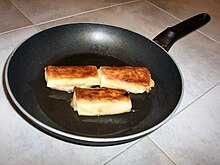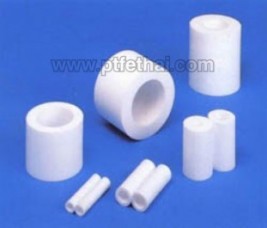Polytetrafluoroethylene (PTFE)
Polytetrafluoroethylene (PTFE) is a synthetic fluoropolymer of tetrafluoroethylene that has numerous applications. The best known brand name of PTFE-based formulas is Teflon by Chemours.[2] Chemours is a spin-off of DuPont Co.,[3] which discovered the compound in 1938.[2]
PTFE is a fluorocarbon solid, as it is a high-molecular-weight compound consisting wholly of carbon and fluorine. PTFE is hydrophobic: neither water nor water-containing substances wet PTFE, as fluorocarbons demonstrate mitigated London dispersion forces due to the high electronegativity of fluorine. PTFE has one of the lowest coefficients of friction of any solid.
PTFE is used as a non-stick coating for pans and other cookware. It is very non-reactive, partly because of the strength of carbon–fluorine bonds, and so it is often used in containers and pipework for reactive and corrosive chemicals. Where used as a lubricant, PTFE reduces friction, wear and energy consumption of machinery. It is commonly used as a graft material in surgical interventions. Also, it is frequently employed as coating on catheters; this interferes with the ability of bacteria and other infectious agents to adhere to catheters and cause hospital-acquired infections.
History[edit]

PTFE was accidentally discovered in 1938 by Roy Plunkett while he was working in New Jersey for DuPont. As Plunkett attempted to make a new chlorofluorocarbon refrigerant, the tetrafluoroethylene gas in its pressure bottle stopped flowing before the bottle's weight had dropped to the point signaling "empty." Since Plunkett was measuring the amount of gas used by weighing the bottle, he became curious as to the source of the weight, and finally resorted to sawing the bottle apart. He found the bottle's interior coated with a waxy white material that was oddly slippery. Analysis showed that it was polymerized perfluoroethylene, with the iron from the inside of the container having acted as a catalyst at high pressure. Kinetic Chemicals patented the new fluorinated plastic (analogous to the already known polyethylene) in 1941,[4] and registered the Teflon trademark in 1945.[5][6]
By 1948, DuPont, which founded Kinetic Chemicals in partnership with General Motors, was producing over two million pounds (900 tons) of Teflon brand PTFE per year in Parkersburg, West Virginia.[7] An early use was in the Manhattan Project as a material to coat valves and seals in the pipes holding highly reactive uranium hexafluoride at the vast K-25 uranium enrichment plant in Oak Ridge, Tennessee.[8]
In 1954, the wife of French engineer Marc Grégoire urged him to try the material he had been using on fishing tackle on her cooking pans. He subsequently created the first Teflon-coated, non-stick pans under the brandname Tefal (combining "Tef" from "Teflon" and "al" from aluminum).[9] In the United States, Marion A. Trozzolo, who had been using the substance on scientific utensils, marketed the first US-made Teflon-coated pan, "The Happy Pan", in 1961.[10]
However, Tefal was not the only company to utilize PTFE in nonstick cookware coatings. In subsequent years, many cookware manufacturers developed proprietary PTFE-based formulas, including Swiss Diamond International, which uses a diamond-reinforced PTFE formula;[11]Scanpan, which uses a titanium-reinforced PTFE formula;[12] and both All-Clad[13] and Newell Rubbermaid's Calphalon, which use a non-reinforced PTFE-based nonstick.[14] Other cookware companies, such as Meyer Corporation's Anolon, use Teflon[15] nonstick coatings purchased from DuPont.
In the 1990s, it was found that PTFE could be radiation cross-linked above its melting point in an oxygen-free environment.[16] Electron beam processing is one example of radiation processing. Cross-linked PTFE has improved high-temperature mechanical properties and radiation stability. This was significant because, for many years, irradiation at ambient conditions has been used to break down PTFE for recycling.[17]This radiation-induced chain scission allows it to be more easily reground and reused.
Production[edit]
PTFE is produced by free-radical polymerization of tetrafluoroethylene. The net equation is
- n F2C=CF2 → −(F2C−CF2)n−
Because tetrafluoroethylene can explosively decompose to tetrafluoromethane and carbon, special apparatus is required for the polymerization to prevent hot spots that might initiate this dangerous side reaction. The process is typically initiated with persulfate, which homolyzes to generate sulfate radicals:
- [O3SO−OSO3]2− ⇌ 2 SO4•−
The resulting polymer is terminated with sulfate ester groups, which can be hydrolyzed to give OH end-groups.[18]
Because PTFE is poorly soluble in almost all solvents, the polymerization is conducted as an emulsion in water. This process gives a suspension of polymer particles. Alternatively, the polymerization is conducted using a surfactant such as PFOS.
Properties[edit]

PTFE is a thermoplastic polymer, which is a white solid at room temperature, with a density of about 2200 kg/m3. According to DuPont, its melting point is 600 K (327 °C; 620 °F).[19] It maintains high strength, toughness and self-lubrication at low temperatures down to 5 K (−268.15 °C; −450.67 °F), and good flexibility at temperatures above 194 K (−79 °C; −110 °F).[20] PTFE gains its properties from the aggregate effect of carbon-fluorine bonds, as do all fluorocarbons. The only chemicals known to affect these carbon-fluorine bonds are highly reactive metals like the alkali metals, and at higher temperatures also such metals as aluminium and magnesium, and fluorinating agents such as xenon difluoride and cobalt(III) fluoride.[21]
| Property | Value |
|---|---|
| Density | 2200 kg/m3 |
| Glass temperature | 388 K [22] |
| Melting point | 600 K |
| Thermal expansion | 112–125 · 10−6 K−1 [23] |
| Thermal diffusivity | 0.124 mm2/s [24] |
| Young's modulus | 0.5 GPa |
| Yield strength | 23 MPa |
| Bulk resistivity | 1016 Ω·m [25] |
| Coefficient of friction | 0.05–0.10 |
| Dielectric constant | ε = 2.1, tan(δ) < 5(-4) |
| Dielectric constant (60 Hz) | ε = 2.1, tan(δ) < 2(-4) |
| Dielectric strength (1 MHz) | 60 MV/m |
| Magnetic Susceptibility (SI, 22 °C) | −10.28×10−6 [26] |
The coefficient of friction of plastics is usually measured against polished steel.[27] PTFE's coefficient of friction is 0.05 to 0.10,[19] which is the third-lowest of any known solid material (BAM being the first, with a coefficient of friction of 0.02; diamond-like carbon being second-lowest at 0.05). PTFE's resistance to van der Waals forces means that it is the only known surface to which a gecko cannot stick.[28] In fact, PTFE can be used to prevent insects climbing up surfaces painted with the material. PTFE is so slippery that insects cannot get a grip and tend to fall off. For example, PTFE is used to prevent ants climbing out of formicaria.
Because of its chemical inertness, PTFE cannot be cross-linked like an elastomer. Therefore, it has no "memory" and is subject to creep. Because of its superior chemical and thermal properties, PTFE is often used as a gasket material. However, because of the propensity to creep, the long-term performance of such seals is worse than for elastomers which exhibit zero, or near-zero, levels of creep. In critical applications, Belleville washers are often used to apply continuous force to PTFE gaskets, ensuring a minimal loss of performance over the lifetime of the gasket.[29]













3.png)

